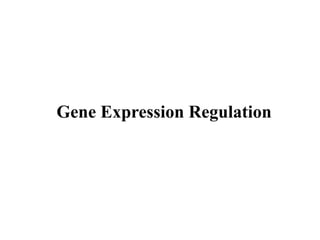
23. Gene expression regulation.pdf
- 2. Ø Gene expression is the process by which the information encoded in a gene is used in the synthesis of a functional gene product. Ø These products are often proteins, but in non-protein coding genes Ø such as ribosomal RNA (rRNA), Ø Transfer RNA (tRNA) or Ø Small nuclear RNA (snRNA) genes § The product is a functional RNA Gene Expression Regulation Gene expression
- 3. Ø Gene expression is the combined process of 1. The transcription of a gene into mRNA 2. The processing of that mRNA, and 3. Its translation into protein (for protein-encoding genes) § Regulation of gene expression includes a wide range of mechanisms that are used by cells to increase or decrease the production of specific gene products (protein or RNA) Gene Expression Regulation Gene expression
- 4. Ø Gene regulation is essential in both prokaryotes and eukaryotes § Why ? Ø It increases the versatility and adaptability of an organism by allowing the cell to express protein when needed. Ø Classification of genes based on expression: Ø Constitutive ( house keeping) genes: are expressed at a fixed rate, irrespective to the cell condition and their structure is simpler. Ø Controllable or inducible genes: Are expressed only as needed. Their amount may increase or decrease with respect to their basal level in different condition. Their structure is relatively complicated with some response elements Gene Expression Regulation Gene expression
- 5. Ø Regulated expression of genes is required for Ø Adaptation: Cells of multicellular organisms respond to varying conditions. Such cells exposed to hormones and growth factors change substantially in shape, growth rate, and other characteristics. Ø Tissue specific differentiation and development: The genetic information present in each somatic cell of a multicellular organism is practically identical. Ø Cells from muscle and nerve tissue show strikingly different morphologies and other properties, yet they contain exactly the same DNA Ø These diverse properties are the result of differences in gene expression Gene Expression Regulation Purposes of Regulation of Gene Expression
- 6. Ø Liver is to remove toxic substances like alcohol from the bloodstream. Ø To do this, liver cells express genes encoding an enzyme called alcohol dehydrogenase. This enzyme breaks alcohol down into a non-toxic molecule. Ø The neurons in a person's brain don’t remove toxins from the body, so they keep these genes unexpressed, or “turned off.” Similarly, the cells of the liver don’t send signals using neurotransmitters, so they keep neurotransmitter genes turned off. Gene Expression Regulation Purposes of Regulation of Gene Expression
- 7. Gene Expression Regulation Purposes of Regulation of Gene Expression
- 8. Ø Different cell types express different sets of genes; However, two different cells of the same type may also have different gene expression patterns depending on 1. Their environment (chemical signals from other cells, mechanical signals from the extracellular matrix, and nutrient levels) 2. Internal state (proteins it inherited from its mother cell, whether its DNA is damaged, and how much ATP it has) § How do these cues help a cell "decide" what genes to express ?? Ø They have molecular pathways that convert information – such as the binding of a chemical signal to its receptor – into a change in gene expression Gene Expression Regulation How do cells "decide" which genes to turn on?
- 9. Ø A growth factor is a chemical signal from a neighboring cell that instructs a target cell to grow and divide. We could say that the cell "notices" the growth factor and "decides" to divide, but how do these processes actually occur? Ø The cell detects the growth factor through physical binding to a receptor protein Ø Binding of the growth factor causes the receptor to change shape, triggering a series of chemical events in the cell that activate proteins called transcription factors. Ø The transcription factors bind to certain sequences of DNA in the nucleus and cause transcription of cell division-related genes. Ø The products of these genes are various types of proteins that make the cell divide (drive cell growth and/or push the cell forward in the cell cycle). Gene Expression Regulation For example, How cells respond to growth factors?
- 10. Gene Expression Regulation For example, How cells respond to growth factors?
- 11. Ø Chromatin accessibility: Relaxed or compressed form Ø Transcription: Sets of transcription factor proteins bind to specific DNA sequences in or near a gene and promote or repress its transcription into an RNA. Ø RNA processing: Splicing, capping, and addition of a poly-A tail to an RNA molecule can be regulated, and so can exit from the nucleus. Ø RNA stability: The lifetime of an mRNA molecule in the cytosol affects how many proteins can be made from it. Small regulatory RNAs called miRNAs can bind to target mRNAs and cause them to be chopped up. Gene Expression Regulation Eukaryotic gene expression can be regulated at many stages
- 12. Ø Translation: Translation of an mRNA may be increased or inhibited by regulators. For instance, miRNAs sometimes block translation of their target mRNAs (rather than causing them to be chopped up). Ø Protein activity: Proteins can undergo a variety of modifications, such as being chopped up or tagged with chemical groups. These modifications can be regulated and may affect the activity or behavior of the protein. Gene Expression Regulation Eukaryotic gene expression can be regulated at many stages
- 13. Gene Expression Regulation Eukaryotic gene expression can be regulated at many stages
- 14. Ø Spatiotemporal gene expression is the activation of genes within specific tissues of an organism at specific times during development. § All cells have the same genes, but not all genes are expressed in every cell at all times. Ø Spatial gene expression– not every gene product needed in every cell type. Ø Temporal gene expression – different genes expressed at different times. Gene Expression Regulation Spatiotemporal gene expression
- 15. Thank you See you tomorrow IA